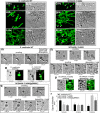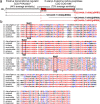Characterization of SCO4439, a D-alanyl-D-alanine carboxypeptidase involved in spore cell wall maturation, resistance, and germination in Streptomyces coelicolor
- PMID: 26867711
- PMCID: PMC4751497
- DOI: 10.1038/srep21659
Characterization of SCO4439, a D-alanyl-D-alanine carboxypeptidase involved in spore cell wall maturation, resistance, and germination in Streptomyces coelicolor
Abstract
This work contributes to the understanding of cell wall modifications during sporulation and germination in Streptomyces by assessing the biological function and biochemical properties of SCO4439, a D-alanyl-D-alanine carboxypeptidase (DD-CPase) constitutively expressed during development. SCO4439 harbors a DD-CPase domain and a putative transcriptional regulator domain, separated by a putative transmembrane region. The recombinant protein shows that DD-CPase activity is inhibited by penicillin G. The spores of the SCO4439::Tn5062 mutant are affected in their resistance to heat and acid and showed a dramatic increase in swelling during germination. The mycelium of the SCO4439::Tn5062 mutant is more sensitive to glycopeptide antibiotics (vancomycin and teicoplanin). The DD-CPase domain and the hydrophobic transmembrane region are highly conserved in Streptomyces, and both are essential for complementing the wild type phenotypes in the mutant. A model for the biological mechanism behind the observed phenotypes is proposed, in which SCO4439 DD-CPase releases D-Ala from peptidoglycan (PG) precursors, thereby reducing the substrate pool for PG crosslinking (transpeptidation). PG crosslinking regulates spore physical resistance and germination, and modulates mycelium resistance to glycopeptides. This study is the first demonstration of the role of a DD-CPase in the maturation of the spore cell wall.
Figures







Similar articles
-
Substrate Inhibition of VanA by d-Alanine Reduces Vancomycin Resistance in a VanX-Dependent Manner.Antimicrob Agents Chemother. 2016 Jul 22;60(8):4930-9. doi: 10.1128/AAC.00276-16. Print 2016 Aug. Antimicrob Agents Chemother. 2016. PMID: 27270282 Free PMC article.
-
In vivo studies suggest that induction of VanS-dependent vancomycin resistance requires binding of the drug to D-Ala-D-Ala termini in the peptidoglycan cell wall.Antimicrob Agents Chemother. 2013 Sep;57(9):4470-80. doi: 10.1128/AAC.00523-13. Epub 2013 Jul 8. Antimicrob Agents Chemother. 2013. PMID: 23836175 Free PMC article.
-
Synthesis of the spore envelope in the developmental life cycle of Streptomyces coelicolor.Int J Med Microbiol. 2015 Feb;305(2):183-9. doi: 10.1016/j.ijmm.2014.12.014. Epub 2014 Dec 24. Int J Med Microbiol. 2015. PMID: 25595023 Review.
-
Characterization of an inducible vancomycin resistance system in Streptomyces coelicolor reveals a novel gene (vanK) required for drug resistance.Mol Microbiol. 2004 May;52(4):1107-21. doi: 10.1111/j.1365-2958.2004.04032.x. Mol Microbiol. 2004. PMID: 15130128
-
Role of the Streptomyces spore wall synthesizing complex SSSC in differentiation of Streptomyces coelicolor A3(2).Int J Med Microbiol. 2019 Sep;309(6):151327. doi: 10.1016/j.ijmm.2019.07.001. Epub 2019 Jul 11. Int J Med Microbiol. 2019. PMID: 31324525 Review.
Cited by
-
The DeoR-like pleiotropic regulator SCO1897 controls specialised metabolism, sporulation, spore germination, and phosphorus accumulation in Streptomyces coelicolor.Commun Biol. 2024 Nov 7;7(1):1457. doi: 10.1038/s42003-024-07164-8. Commun Biol. 2024. PMID: 39511385 Free PMC article.
-
High-Resolution Analysis of the Peptidoglycan Composition in Streptomyces coelicolor.J Bacteriol. 2018 Sep 24;200(20):e00290-18. doi: 10.1128/JB.00290-18. Print 2018 Oct 15. J Bacteriol. 2018. PMID: 30061355 Free PMC article.
-
Penicillin-Binding Proteins, β-Lactamases, and β-Lactamase Inhibitors in β-Lactam-Producing Actinobacteria: Self-Resistance Mechanisms.Int J Mol Sci. 2022 May 18;23(10):5662. doi: 10.3390/ijms23105662. Int J Mol Sci. 2022. PMID: 35628478 Free PMC article. Review.
-
The SCO2102 Protein Harbouring a DnaA II Protein-Interaction Domain Is Essential for the SCO2103 Methylenetetrahydrofolate Reductase Positioning at Streptomyces Sporulating Hyphae, Enhancing DNA Replication during Sporulation.Int J Mol Sci. 2022 Apr 30;23(9):4984. doi: 10.3390/ijms23094984. Int J Mol Sci. 2022. PMID: 35563376 Free PMC article.
-
FtsZ phosphorylation pleiotropically affects Z-ladder formation, antibiotic production, and morphogenesis in Streptomyces coelicolor.Antonie Van Leeuwenhoek. 2023 Jan;116(1):1-19. doi: 10.1007/s10482-022-01778-w. Epub 2022 Nov 16. Antonie Van Leeuwenhoek. 2023. PMID: 36383329 Free PMC article.
References
-
- Flärdh K. & Buttner M. J. Streptomyces morphogenetics: dissecting differentiation in a filamentous bacterium. Nat. Rev. Microbiol. 7, 36–49 (2009). - PubMed
-
- Hopwood D. A. Streptomyces in nature and medicine: The antibiotic makers. Oxford University Press, New York (2007).
-
- Davies J. Specialized microbial metabolites: functions and origins. J. Antibiot. (Tokyo) 66, 361–364 (2014). - PubMed
-
- van Wezel G. P. & McDowall K. J. The regulation of the secondary metabolism of Streptomyces: new links and experimental advances. Nat. Prod. Rep. 28, 1311–1333 (2011). - PubMed
Publication types
MeSH terms
Substances
Grants and funding
LinkOut - more resources
Full Text Sources
Other Literature Sources
Molecular Biology Databases

